TL;DR: How Do I Keep Members Engaged in My Paid Group? (Membership Engagement Strategy Tips Needed)
You don’t just hope people show up and stick around — you design for it. Keeping members engaged in your paid group means thinking beyond content drops and email blasts. You need an actual membership engagement strategy — one that’s behavior-driven, scalable, and rooted in real human connection.
Here’s the short version of what works:
- Start with community, not just content — people stay for the interaction, not the PDFs
- Personalize the experience using smart segments, quizzes, and automation tools (without making it weird)
- Create reasons to come back — habit loops, progress tracking, gamified rewards, and “what’s next” moments
- Empower your members to contribute, lead, and connect with each other — not just with you
- Measure what matters — track retention, upsells, reactivation, and cohort activity so you can double down on what actually drives results
Bottom line? Engaged members don’t just stay longer — they spend more, refer more, and help your business grow from the inside out.
👇 Scroll down to learn how to build a system that does this — one that turns your membership site from a static content vault into a thriving, high-conversion ecosystem.
You’re throwing a party — whooooo! The lighting’s perfect, the playlist is fire, the drinks are flowing, and the snack table? Curated. Everything looks incredible… but there’s just one problem: no one’s on the dancefloor. People showed up, sure, but they’re clinging to the walls, scrolling their phones, not talking to each other.
Vibe? Dead. Energy? Flat. And you’re standing there wondering how it all fell apart.
That’s exactly what it feels like when you launch a membership site without a real membership engagement strategy.
You’ve got the platform. You’ve built the content. Maybe it’s an online course, a resource vault, or a private membership community. You even nailed your onboarding flow. But your members aren’t logging in. They’re not joining the conversation. They’re not sticking around. And hoping it’ll magically fix itself? Risky.
💸 The global subscription economy is projected to hit $1.5 trillion by 2025, more than double its size in 2020. That means people are spending — but the question is, are they spending with you?
😬 Meanwhile, 67.3% of membership site owners say they’re unhappy with community engagement.
⏳ And over a third of membership sites have existed for less than a year. Only 14% make it past the five-year mark.
The gap between potential and reality is massive. Which means if you can fix this piece — the engagement piece — you’ve got leverage.
And if you don’t?
According to my research: 🧾 It can cost up to 5x more to acquire a new member than retain an existing one 💡 Existing members are 60–70% more likely to buy again — compared to just 5–20% for new leads 💸 The average value of a lost customer? Around $243
So yeah, low engagement isn’t just annoying. It’s expensive.
And it’s the #1 reason so many subscription-based membership models struggle to scale.
But the good news is: you can fix it.
This guide walks you through the exact steps to build a membership engagement strategy that actually works — not just for logins, but for interaction, connection, referrals, and revenue.
Because a quiet membership site is a missed opportunity.
But one that’s alive and buzzing? That’s your unfair advantage.
🧠 What Are the Best Membership Engagement Strategies Right Now? Top Questions Answered
You’ve got to build momentum and then make it visible. Member retention isn't about churning out more content — it's about helping people feel like they're progressing. That means small wins, milestones, nudges, and even a surprise bonus or two. These moments keep your membership experience sticky and satisfying.
🛠️ Use Thrive Apprentice to create learning paths, drip schedules, and milestone unlocks that make members feel seen and motivated.
Start with smart segmentation. Instead of building 50 versions of your welcome sequence, use tools like Thrive Quiz Builder to segment users by interests or goals. Then pair that data with Thrive’s Conditional Display to display tailored testimonials, CTAs, and offers.
This isn't just scalable — it feels deeply personal to the member on the other side of the screen.
Consistency comes from design — not luck. An engaged member community isn’t built on “posting more.” It’s built on rhythm: weekly touchpoints, live hangouts, welcome rituals, member wins, and spaces that feel curated (not chaotic).
You want your members to know what’s happening and want to show up.
The best automation is invisible. Think behavior-based triggers — like a friendly email if someone hasn’t logged in, or a bonus drop when they complete a module.
🛠️ Use a tool like Uncanny Automator with ConvertKit or ActiveCampaign to trigger smart automations tied to your member’s behavior — not a random calendar date.
Track what matters. Segment members by activity and compare cohorts: How long do engaged members stay? How often do they upgrade or refer friends?
Even a basic Google Sheet can show you patterns. But most platforms like your membership platform, CRM tool, or payment gateway plugin should be able to provide this data to help you answer this question.
Engaged members don’t just stick around. They spend more and spread the word.
If you’re over-communicating, you're training members to tune you out. Instead, build trust by letting them set preferences — and give breathing room with “quiet” cycles.
Highlight one high-impact action instead of flooding them with updates. That’s how you respect attention and still drive action.
Re-engagement isn’t about guilt — it’s about relevance. Ask one powerful question: “What would you love to see next?” Offer a comeback bonus, a quick-start checklist, or a mini challenge.
🛠️ Use Thrive Quiz Builder to make fun, low-friction re-entry quizzes/surveys that show members you're listening — and make them excited to dive back in.
Absolutely — if it’s tied to real motivation. When members can see their progress or earn perks that unlock access, you’re tapping into proven behavioral psychology.
🛠️ Tools like GamiPress are great for displaying progress bars, rewards, and badges in a way that boosts engagement (without the cheese).
Yes — if you want sustainability. When members help shape the culture, they stick around longer. Peer-led events, spotlight stories, and moderator roles turn passive participants into proud co-creators.
It’s how your community stops being a “thing you manage” and starts being something that manages itself.
Don’t panic — pivot. A crisis (economic downturn, social unrest, burnout) is when people need your community the most. Shift your tone, run check-ins, prioritize support.
The brands and communities that lean in during chaos are the ones members never forget.
😓 Why Most Membership Engagement Strategies Fail (Even the Fancy Ones)
I’ve seen it (and yeah, I’ve done it too): you spend weeks setting up your membership platform. You’ve got the content. The email sequences. Maybe even a shiny onboarding quiz. You hit publish… and then?
Crickets.
It’s a painful realization — and a common one. Most membership engagement strategies fail because they focus on production, not participation.
We assume if we give members “enough stuff,” they’ll automatically engage. We assume if we give members “enough stuff,” they’ll automatically engage. But that’s not how humans — or online communities — work.
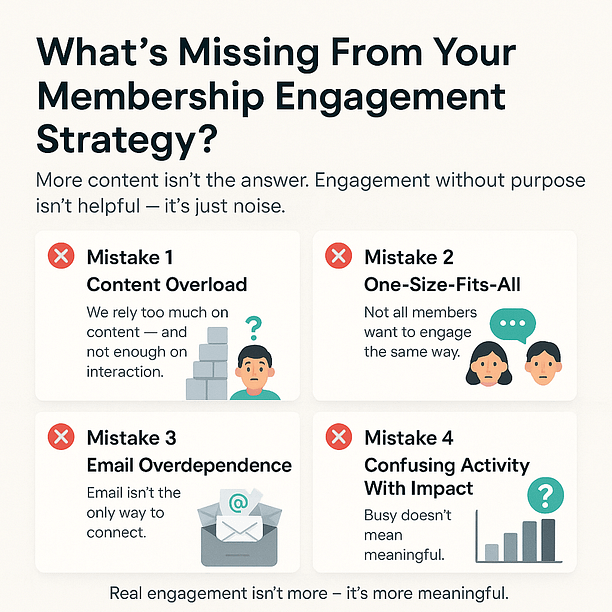
Here’s the truth I’ve learned the hard way — and the honest way.
Before I worked in tech or touched conversion tools, I ran a few small, local member communities. No SEO. No paid ads. Just me, Google, and my own awkward enthusiasm sharing stuff with friends and strangers online. And they worked. People showed up. People stayed. Why? Because it felt personal. Relevant. Alive.
That’s what’s missing from most membership site strategies today.
The biggest mistakes?
- Relying too heavily on content output without encouraging member interaction
- Assuming all members want to engage the same way (they don’t)
- Overusing email as a catch-all solution
- Confusing “more activity” with meaningful community engagement
Because here’s the thing: engagement without purpose isn’t helpful — it’s just noise.
And when your member engagement plan lacks structure, it shows.
🧠 “A quiet community isn’t just a missed opportunity — it’s a silent churn machine. And if you wait to fix it after members leave, it’s too late.”
Want proof? Studies show that 78% of organizations that improved their membership renewal rate had a clear plan to boost engagement.
That means having a thoughtful content strategy for membership sites directly impacts retention — and your bottom line.
I say this with love, because I’ve made all of these mistakes myself — and I’ve also learned how to fix them.
If you want a thriving membership program, you have to build a member experience that feels intentional. One that encourages real participation, not passive consumption.
Because members can feel when something was thrown together. They know the difference between busywork and belonging.
And the moment they stop feeling connected? That’s when they churn.
Let’s fix that.
🔥 What Happens When You Ignore Member Engagement?
I won’t sugarcoat it: when you treat engagement like a “nice-to-have,” you don’t just miss out on community magic. You set your whole membership program up to quietly bleed.
Your renewal rates start to tank — not because your content is bad, but because members don’t feel connected.
Your community space? It becomes a ghost town. New members log in, see tumbleweeds, and bounce — often telling others, “Yeah, it looked cool, but no one was really active.” And now you’ve got a new problem: you’re stuck in constant acquisition mode — burning energy (and ad dollars) trying to replace members who never should’ve left in the first place.
Even worse? Upsells stop working. Why? Because trust was never built. And without trust, your best offers fall flat, no matter how smart the funnel is.
📉 “We’ve seen it. Gorgeous sites. Brilliant content. No heartbeat. It’s like building a luxury hotel no one checks into twice.”
This is the part most creators don’t talk about — because it’s uncomfortable. But that’s also why fixing it can become your biggest advantage.
Next: how to turn things around (and build a member experience they’ll actually miss when they log out).
🚧 Build Your High-Converting Engagement Strategy
Let’s get real for a moment.
It’s easy to fall into the trap of thinking “engagement” just means more likes, more comments, or more time-on-page. But in a membership program, engagement isn’t about vanity metrics — it’s the fuel that powers everything: retention, referrals, upsells, and lifetime value.
If your engagement isn’t strategic, it’s accidental. And accidental engagement doesn’t scale.
At Thrive, we’ve seen the difference between a content hub and a true member experience. One earns passive views. The other builds movements.
This next section is where we shift gears — from identifying the cracks in your current setup to building a membership engagement engine that actually converts. Whether you're just starting out or trying to re-engage a community that’s gone quiet, these aren’t just feel-good ideas. They’re practical plays that:
You don’t need a bigger team or flashier tech. You need intention, smart structure — and the right tools to pull it off.
So let’s break it down. Step-by-step. No fluff. All traction.
💬 How Do I Build a Community Members Actually Want to Be In?
A great membership program is more than just gated content — it’s a space people want to return to, even when they don’t "need" something. That’s the difference between a transactional experience and a thriving member community.
And yes, it’s absolutely possible to create that kind of space — even if you're not a community manager by trade.
Here’s how to build a member community that actually feels alive:
1. Choose the right platform — and make it feel private
Skip the generic Facebook group unless your audience specifically loves it. Opt for platforms that let you build a dedicated experience with a sense of belonging. Tools like BuddyBoss, bbPress (for WordPress users), or even Discord work well — as long as you frame the space as the place to be, not just another app to ignore.
Your goal isn’t to create “just another forum.” It’s to build a home base for your members.
And if you want to mix your membership platform with an online course experience, take a look at Thrive Apprentice, MemberPress, or WishList Member.
2. Create entry points for peer-to-peer conversation
Most communities flop because they only talk at members — not with them.
Start threads with questions, not announcements. Use conversation prompts. Set weekly or monthly themes. Ask for opinions. Celebrate wins. Encourage introductions. People join for the content — but they stay for the people. And, of course, don’t forget to respond to your members. That will show them you’re genuinely interested in what they have to say.
💡 Pro tip: The first five minutes matter. If a new member logs in and sees no signs of life, they’re likely gone forever.
3. Nominate community leaders (aka “Member Champs”)
Don’t try to run the show alone. You will burn out.
As your community grows, tap into your most engaged members and give them a leadership role: moderators, greeters, live chat hosts, or “topic owners.”
These roles give your power users a sense of ownership — and they help scale engagement without you burning out.
Even better? When new members see peers taking the lead, it normalizes participation.
4. Design discussion spaces that feel intentional and intimate
Avoid dumping everyone into a giant, unstructured feed. Instead, build themed areas or rooms based on your members’ interests or journeys. Think: “New Member Corner,” “Tech Support,” “Mindset Zone,” “Live Events Lounge,” etc.
When people know where they belong, they’re more likely to speak up.
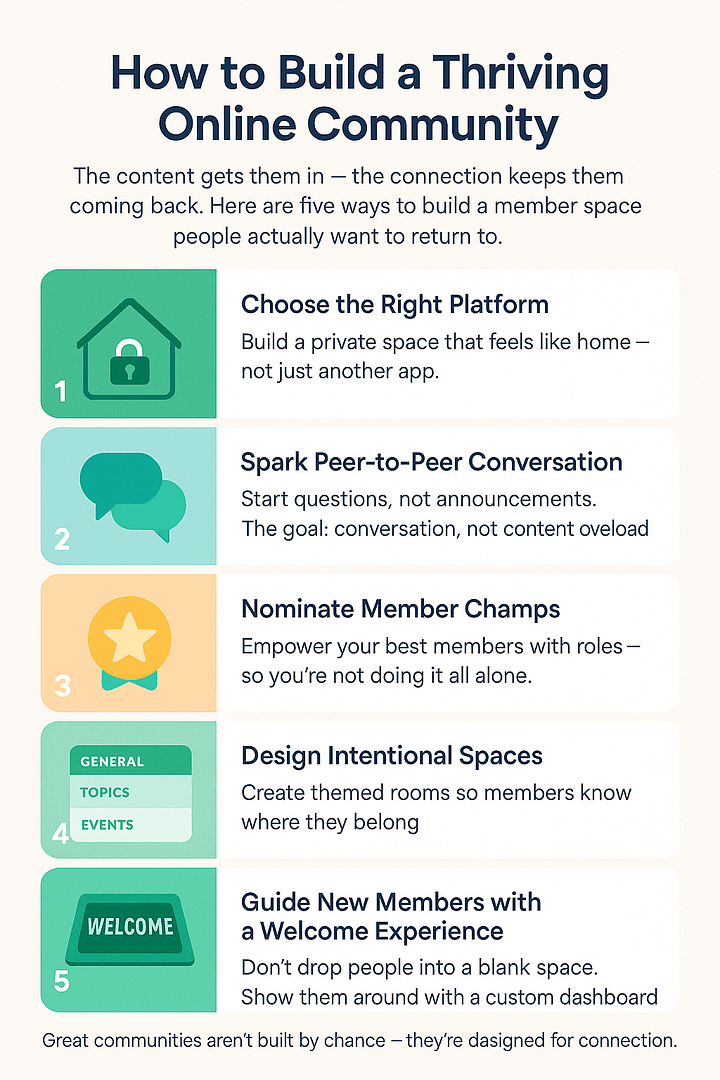
5. Create a welcome experience that makes it all click
That first impression counts. Don’t send new members into a blank forum. Guide them.
🛠️ Use your chosen membership plugin to build an interactive welcome dashboard that introduces key spaces, shows active threads, and encourages them to say hello. Think of it like a personalized map — one that makes joining the conversation feel easy, even for introverts.
🧠 How Do I Personalize the Member Experience Without Doing It All Manually?
You’ve probably heard that personalization is the secret to higher engagement, better retention, and stronger revenue – and the research backs this up. But if the idea of manually customizing every interaction makes you want to throw your laptop out the window — you’re not alone.
The good news? You can create a tailored experience at scale without becoming a full-time tech wizard (or cloning yourself). It just takes a few smart systems layered together.
1. Segment based on real signals — not assumptions
The first step is knowing who you’re talking to. Don’t guess. Instead, use real actions and choices to segment your members:
Even three segments — like “beginner,” “intermediate,” and “power user” — can dramatically sharpen your messaging.
2. Use your email platform to power dynamic experiences
If you’re using ConvertKit, ActiveCampaign, or similar, you’ve already got the engine. Now it’s about creating the tracks.
Set up tags or custom fields based on your segments, then write modular emails with conditional blocks. That way, one email can speak to different people in different ways — without extra effort every time you hit send.
💡 Example: Instead of “What did you think of Module 3?” you can say:
“If you’ve finished Module 3, here’s a bonus tip. Still working through it? Here's a quick motivator.”
3. Display dynamic content inside your site — not just in emails
Why stop at inboxes? Tools like Thrive Apprentice let you show or hide content based on a member’s tag, progress, or status (you can learn more about dynamic text in Thrive Apprentice here).
This means your homepage, dashboard, or even a course module can look different depending on who’s logged in. You can show:
It feels personal — without you having to touch a thing.
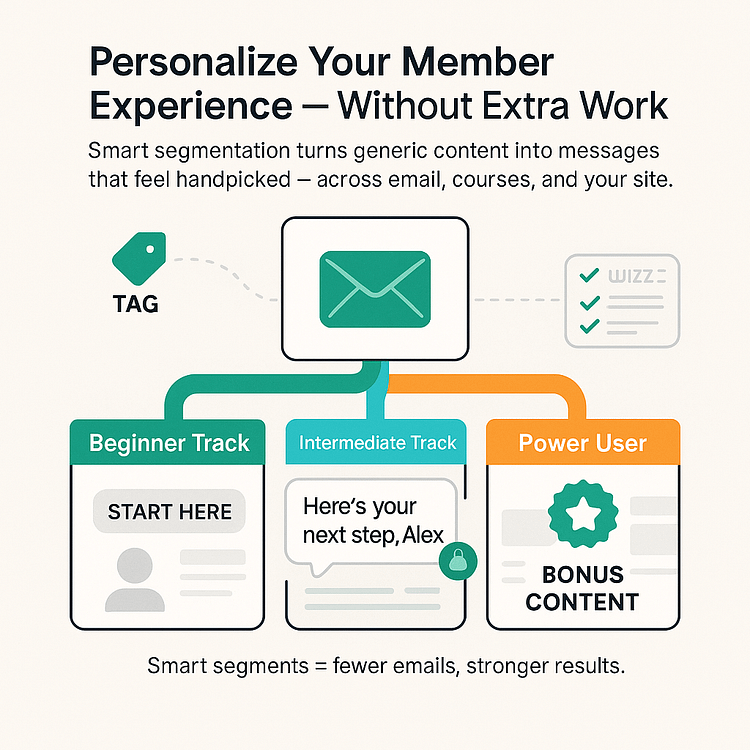
4. Automate nudges and resource drops based on milestones
Finally, tie your automations to behavioral milestones, not fixed schedules.
Example: Instead of sending “Week 2 Resources” to everyone at the same time, send it when someone completes their first lesson, attends a live session, or hits a 7-day streak.
Tools like Thrive Apprentice (or an automation tool) + your email platform make this easy — and your members will feel like your timing is always just right.
---
Bottom line? Personalization doesn’t mean doing everything manually. It means setting up smart systems that respond to real people — and make your member experience feel like it was built just for them.
Want a walkthrough? Here’s how to use dynamic content with Thrive Architect →
🎮 How Can I Use Gamification Without It Feeling Cheesy?
Gamification often gets written off as fluff — like slapping gold stars on everything and hoping people care. But real gamification isn’t decoration — it’s behavioral design.
When done well, it taps into motivation, momentum, and identity. It makes members want to keep showing up.
Here’s how to do it right inside your membership program:
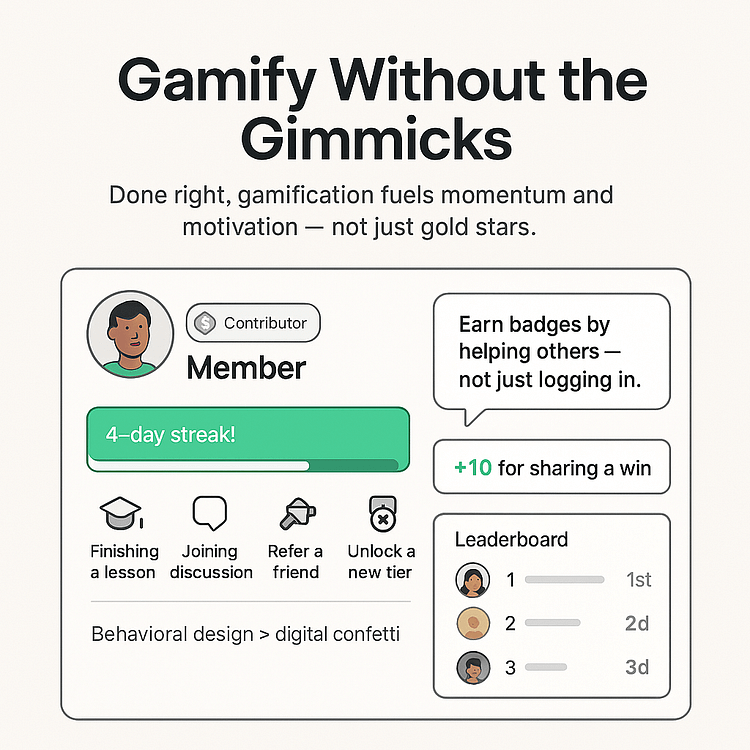
🏆 Gamification works best when it’s subtle, earned, and tied to real value. Do that, and your members won’t just consume — they’ll compete (in a good way).
📊 How Do I Measure Whether My Engagement Strategy Is Working?
You can’t fix what you’re not measuring — and in membership programs, engagement isn’t a vibe. It’s a set of signals. The right ones will tell you whether members are just lurking… or actually finding value.
Here’s how to measure what matters:
1. Track KPIs that tie to revenue — not just interaction
These numbers are more important than raw comments or forum posts.
2. Track engagement by cohort, not just total volume
Group your members by stage or behavior: new joiners, active regulars, silent lurkers, recent drop-offs. This makes it way easier to spot patterns and see which strategies move the needle for each group.
3. Use your tools to build dashboards that reveal what’s actually happening
This will highly depend on whether your membership tool has this type of functionality. But, if it does, you can create custom dashboards that show logins, completions, forum activity, and offer engagement — all in one place.
Bonus tip: Overlay this with email and click data to see which types of content lead to action.
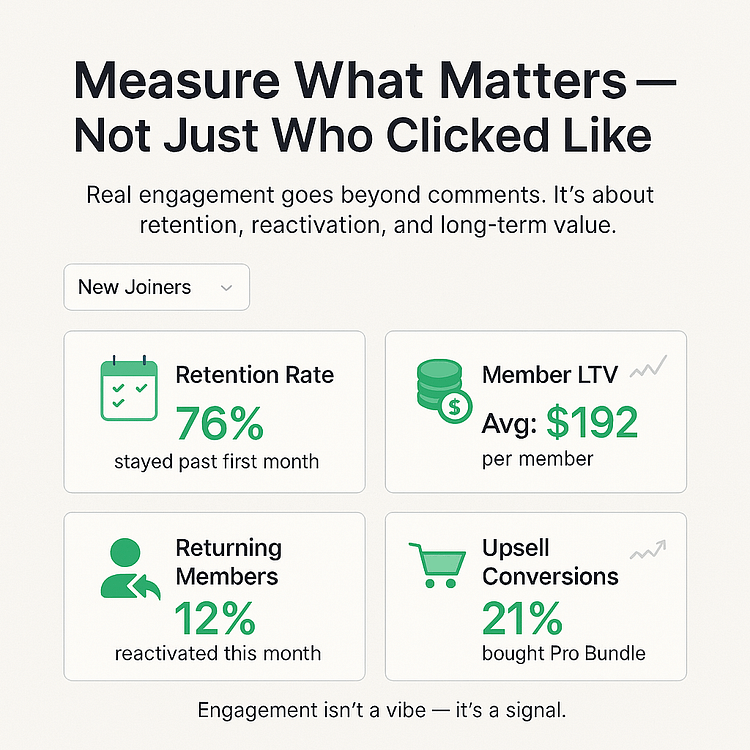
4. Set up trackable learning journeys
Add internal links inside modules, dashboards, or community posts that guide members toward action — then track the click-throughs. You’ll start to see what they’re curious about, what they skip, and where drop-off happens.
🧠 One of our clients doubled LTV just by shifting their “value delivery” into an interactive challenge. When you measure engagement like it matters, it suddenly starts to matter more.
😴 What If My Members Are Tired of Notifications and Emails?
We’ve all been there — your inbox is full of “check this out!” emails you meant to open… but didn’t. Now imagine how your members feel when they join a program and suddenly get pinged five times a week.
Engagement fatigue is real. But it doesn’t mean your strategy’s broken — it just means it needs boundaries.
Here’s how to keep your member communication welcome, not overwhelming:
1. Let members choose how and when they hear from you
Give them simple, visible options to adjust their notification preferences — like choosing between email summaries, real-time pings, or “only the big stuff.” The more control they have, the more trust you earn.
2. Build in intentional “quiet weeks” or off cycles
You don’t have to be in constant communication. In fact, scheduling regular low-touch weeks (especially after intense launches or challenges) can help reset attention and reduce burnout.
3. Keep your messages focused — 1 or 2 key actions max
Instead of a laundry list of updates, highlight *what matters right now*. Want them to join a live call? Watch a module? Celebrate a member win? Pick one or two things, and make them crystal clear.
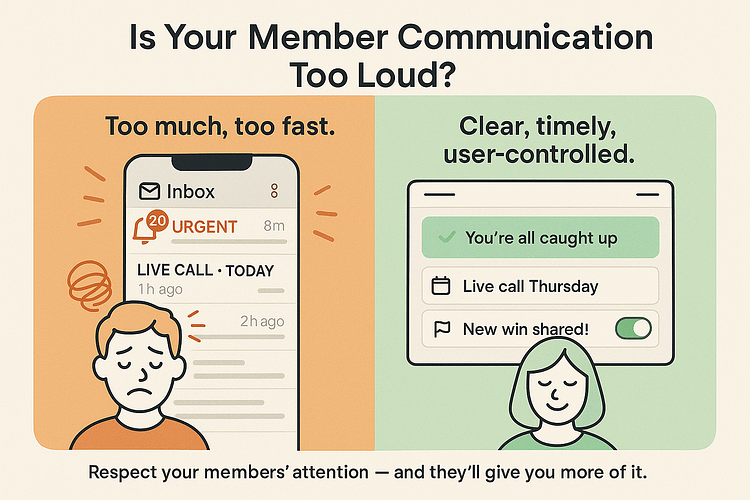
4. Lean into “pull content” — not just push
Instead of always pushing updates via email or notifications, create a member dashboard they want to visit. This is where tools like Thrive Architect shine — you can build a dynamic, visually compelling hub that updates automatically based on member activity.
💡 Engagement isn’t about shouting louder. It’s about saying the right thing at the right time — and knowing when to stay silent.
Next, we’ll talk about what to do when members fall off the radar — and how to bring them back without pestering them.
🔄 How Do I Re-Engage Inactive Members Without Feeling Pushy?
Silence doesn’t always mean someone’s gone for good. Sometimes life gets in the way. Other times, they just forgot why they signed up.
The goal isn’t to chase — it’s to reopen the loop with care, not pressure.
Here’s how to re-engage dormant members without sounding desperate:
1. Send a personal “We noticed you disappeared” email
Skip the generic blast. Write a simple, friendly message that acknowledges their absence — and shows you actually care. Something like:
“Hey [Name], noticed it’s been a while since you logged in. If you’re stuck, overwhelmed, or just forgot we’re here — that’s totally okay. We’d love to help you jump back in when you’re ready.”
Authenticity beats automation here.
2. Offer a comeback bonus, live call, or mini challenge
Sometimes people need a reason to return — especially if they’ve drifted. Give them one. Try:
Low-barrier. High-impact.
3. Ask a single, intentional question
“What would you love to see next inside the community?”
This works better than a survey or a “How can we help?” email. It feels human, and you’ll learn exactly what’s missing.
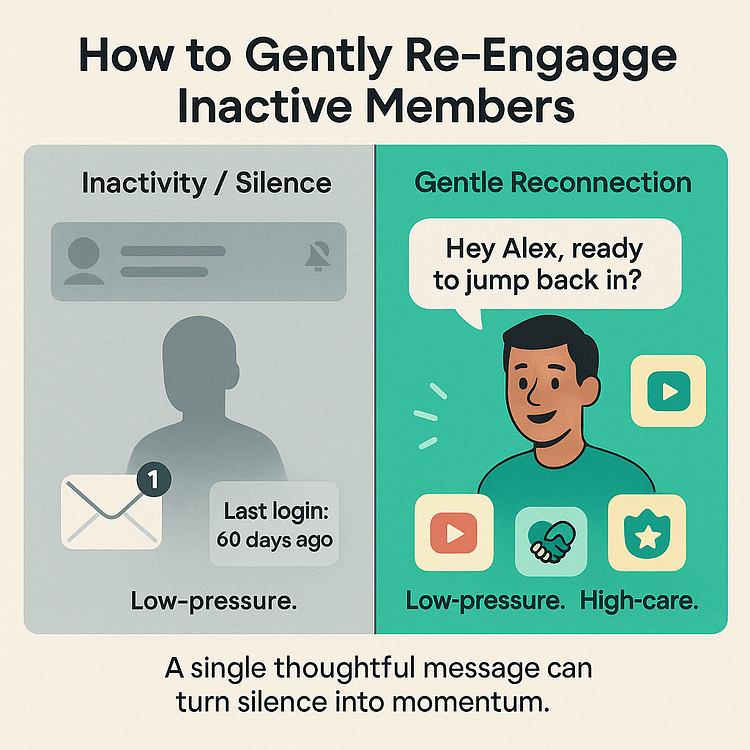
4. Use conditional logic in your email tool to test responses
Tag people who click. Segment those who reply. Create a short re-engagement sequence based on behavior — not blind guesswork.
Most email platforms (like ConvertKit or ActiveCampaign) can handle this with ease.
💌 Sometimes, all it takes is one well-timed message to remind someone why they joined. Make it count — and make it personal.
Want a template? Here’s a Thrive-style reactivation email sequence you can swipe → (optional CTA).
🌪 What Should I Do When Crisis Hits — and Engagement Drops Overnight?
When something big happens — a global event, local emergency, or even a tech meltdown — engagement can tank fast. And it’s tempting to go quiet until things blow over.
But that silence? It can feel like abandonment.
Here’s how to respond when crisis shakes your member community:
1. Acknowledge it head-on — quickly and humanely
Don’t pretend everything’s normal. A short, honest message like “We see what’s happening, and we’re here for you” builds trust faster than silence ever could.
Whether it’s a global issue or a personal loss felt by your audience, recognize it with care.
2. Switch your tone from promotional to supportive
This isn’t the time to push offers or deadlines. Shift your messaging to focus on reassurance, clarity, and presence.
Even a single helpful post or resource list can go a long way.
3. Host informal “pop-up” sessions to hold space
Jump on a quick live call — Zoom, Google Meet, whatever’s easiest. It doesn’t need to be structured. Just show up. Invite questions. Offer calm. Let people talk.
Sometimes your presence alone is the anchor.
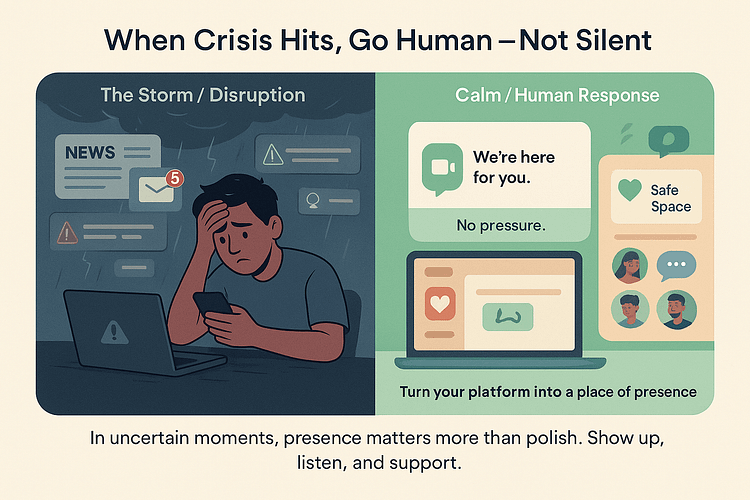
4. Reframe your member space as a refuge, not a feed
Make it clear: this is a no-pressure zone where people can connect, vent, or just scroll in peace. Pin that message to your dashboard or forum. Let your member community be the buffer against burnout.
🧠 When everything feels uncertain, people crave connection. Don’t go dark. Go human. That’s when loyalty is built — even in silence.
If you’ve built your membership strategy on value and trust, this is when it really pays off. Want help turning your member area into a calm, conversion-friendly dashboard? Try Thrive Architect to build it your way →
💬 FAQ: Membership Engagement Strategy
At its core, an effective strategy goes beyond just publishing content. It combines personalized touchpoints, peer-to-peer connection, meaningful progress milestones, and clear conversion goals.
That means you’re not just tracking logins — you’re designing an experience that keeps your membership community active, valued, and coming back for more.
As a general rule, once a week is a good starting point — but the real answer is: let them choose. Some members love regular updates. Others prefer space.
Give them control over their notification preferences, and be intentional with every message you send. Overcommunication can lead to member fatigue, and that’s a silent churn risk.
Think of automation as your behind-the-scenes assistant — not your voice.
Use email workflows, milestone-based logic, and conditional content (like quizzes or tag-based unlocks) to gently guide members along their journey.
But here’s the golden rule: don’t automate empathy. Automate the logistics, yes — the reminders, the nudges, the “here’s what’s next.” But connection? That part still needs a human touch.
Absolutely. Tools like Thrive Architect and Thrive Apprentice let you build personalized dashboards, drip content, and create member-only experiences without hiring a dev team.
Want to segment based on behavior or quiz results? Thrive Quiz Builder has you covered. It’s all about building an experience that adapts — without losing the personal feel that makes communities thrive.
💡 Membership Isn’t About Content. It’s About Connection.
Remember that party analogy from the start?
The lighting, the music, the setup — it doesn’t matter if no one feels welcome on the dancefloor.
A great membership engagement strategy isn’t about throwing more features at your members. It’s about curating a space that feels alive — where people want to show up, stay, and invite others in.
Because here’s the truth:
Engagement isn’t a feature — it’s your funnel.
It’s your retention plan. Your upsell engine. Your long-game growth strategy.
When you get this part right, your members don’t just stick around — they invest. They participate. They build with you.
And that’s when your online membership site stops being a product… and starts becoming a community.
---
💪 Ready to Build a High-Retention, Growth-Driven Membership?
👉 Start creating smart, sticky, and scalable member experiences with Thrive Suite.
Whether you're designing your first welcome flow or leveling up your current membership platform, Thrive gives you the tools to turn your site into the kind of space people actually want to be in.


